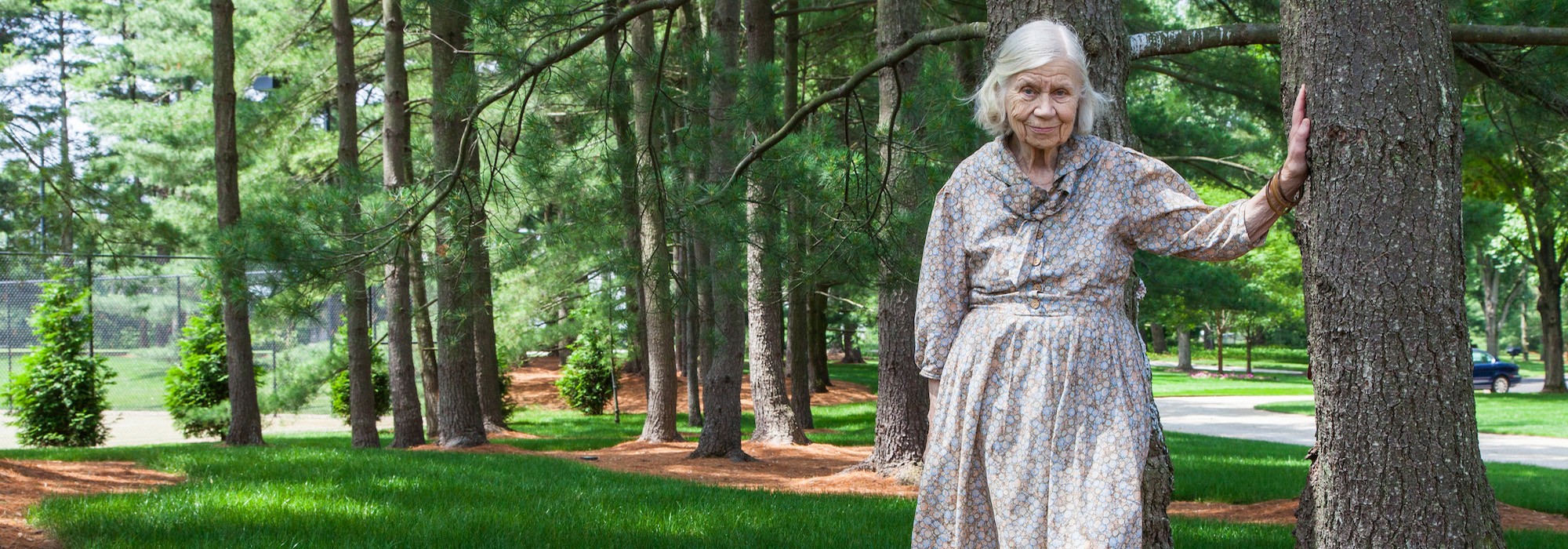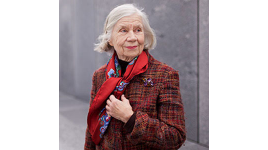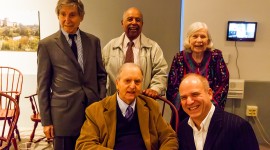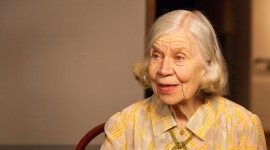Remembering Harriet Pattison
By Charles A. Birnbaum
I met Harriett Pattison on June 17, 2015, at the Architectural Archives at the University of Pennsylvania. It was one of those perfect June days. We were preparing to shoot an oral history with Harriet that would make her life, work, and approach to landscape architecture visible. Our crew had arrived earlier and completed our set up for the five-day stint. She arrived fashionably late on the arm of her son Nathaniel Kahn, the Academy Award-nominated documentary filmmaker of My Architect, about his father Louis Kahn. The other hand clutched a well-worn walking stick.
This was the thirteenth oral history The Cultural Landscape Foundation (TCLF) was producing. Earlier ones had predominantly focused on landscape architects who are considered “The Gods” – M. Paul Friedberg, Lawrence Halprin, Richard Haag, Carol Johnson, Cornelia Hahn Oberlander, and Laurie Olin. When we say Paul, Larry, Rich, Carol, Cornelia, and Laurie most landscape architects of a certain generation know who you are talking about solely by hearing their first name.
Pattison’s entrance was quiet and patrician, and she quickly revealed a shy, soft-spoken vulnerability. We sat down and almost immediately Harriet revealed that a day prior, her cat, “who was the only other living thing that she shared a home with,” had died. She seemed dejected and weighted down, and she was hunched over the table. She seemed somewhat intimidated and distracted by the camera pointed at her, the lights looming over her, and the crew watching her every movement.
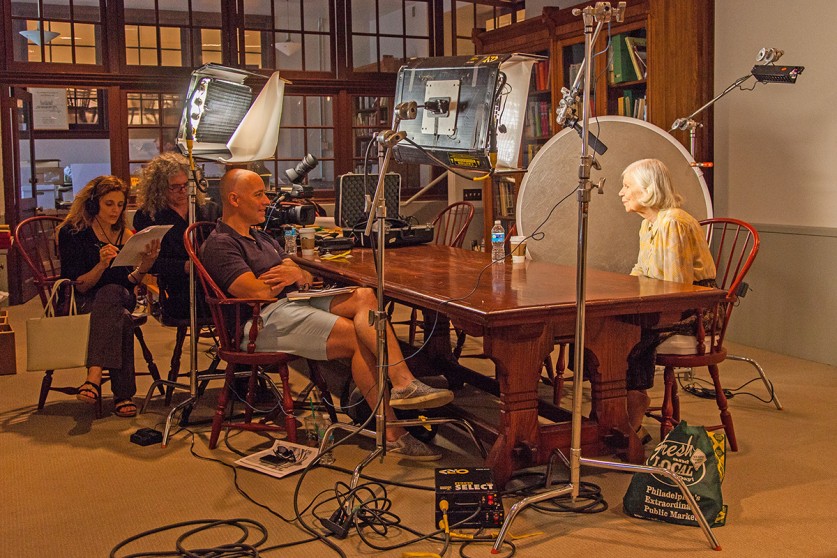
We talked and before too long infectious laughter began to take hold. The intrusive presence of the production equipment no longer concerned Harriet. Video started rolling, and we began our work together. What we were then privileged to learn, and later share widely to tens of thousands, is that her life did not follow the path seemingly prescribed for young women coming of age in the 1950s; in fact, it was not easy. By 1962 she was an unwed mother with a newborn, Nathaniel, and the father, architect Louis Kahn was married to another woman. Over those days we learned of a life dealing with many “curve balls” and challenges. But at its core her life was one of quiet strength, a strength that she got from a deep well of love. There was her once-in-a-lifetime soul mate and great love, Louis Kahn, and a supportive, warm-hearted son, Nathaniel. This fortified Harriet and provided the essential emotional and intellectual foundation for her to pursue a modest landscape architecture practice creating a small number of thoughtfully designed residential gardens, a notable corporate campus, and, with Kahn, two iconic public works – the Kimbell Museum of Art in Fort Worth, TX, and FDR Four Freedoms Park in New York City.
If ever there was an opportunity to help tell someone’s story of making it in a man’s world, this was it. By the end of the five days, having sat at the archives and then visited several projects she’d designed, Harriet had cast her spell over me and a friendship blossomed.
In the years that followed, Harriet had newfound verve and vitality. Her enthusiasm was infectious. The oral history was unveiled in 2016 in tandem with an exhibition of her work at the Penn Archives. In October of that year Harriet was inducted as a Fellow of the American Society of Landscape Architects (ASLA). At the investiture ceremony I had the privilege of being Harriet’s escort when she went up to the stage to get her honor. On either side of the stage were screens onto which images of her projects were projected. The entire audience rose to its feet when they saw photos of the Kimbell; few, however, knew the landscape architect behind this iconic work. In fact, the audience roared in a way I have never seen happen before or since at one of these ceremonies, and making her way through a sea of black tie and formal wear, was Harriet, luminous in her multicolored folk-inspired dress suffused with small paisley and floral motifs. Nathaniel was just off stage as she made her way to the podium; he had a tear in his. She beamed a megawatt smile as she received her honor.
After the ceremony concluded, Nancy Somerville, ASLA’s then CEO, approached Harriet and asked, “Why have I never heard of you?” Harriet said nothing. The silence was awkward. I replied, “Harriet was a one-person office. She did not have a communications director and staff to help apply for ASLA awards.”
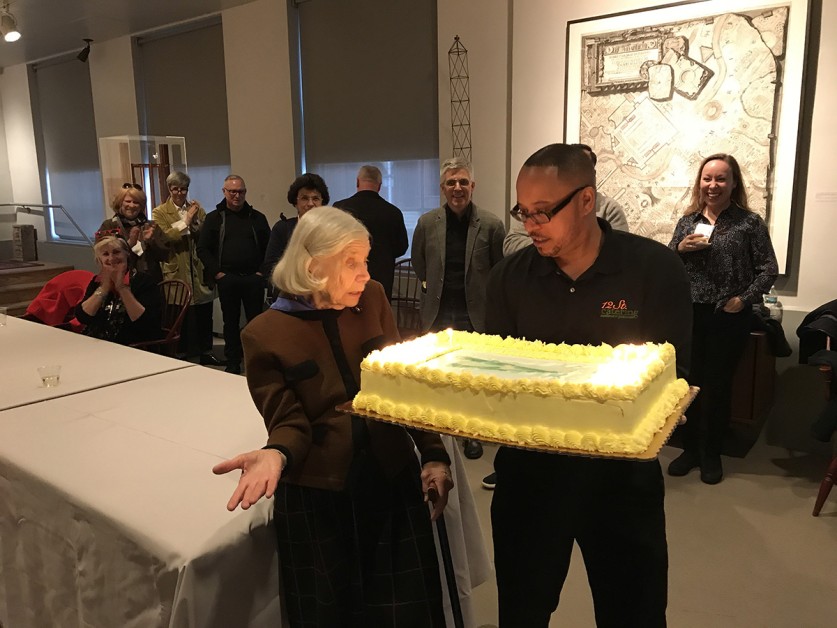
Other adventures with Harriet (and Nathaniel) followed including a birthday bash at the Penn archives (complete with a cake that featured Harriet’s plan for Four Freedoms Park), and a magical visit to her rustic summer home located in a former lighthouse on a tiny island off Rockport, ME (to get to the island, we first traveled by motorboat and then transferred to a rowboat, and once there the generator, located in an outbuilding, was turned on only when we needed electricity). In 2017, TCLF organized a panel presentation at Modernism Week in Palm Springs, CA, that featured Harriet and Cornelia Hahn Oberlander, two leading women landscape architects of the Modernist Era. Harriet, then 88, and Cornelia, then 95, hit it off and soon were thick as thieves. One of the many things they had in common, each had worked for Dan Kiley in Vermont.
The following morning, we all had breakfast together. The two of them were giddy. Following breakfast, I was politely dismissed so the two could, as Harriet put it, have “girl time.”
In October 2020, during the height of Covid, Harriet published, Our Days Are Like Full Years: A Memoir with Letters from Louis Kahn. A few months after its publication, I attended a Zoom event organized for Harriet’s friends during which she read several passages from the book. As she recounted poignant, private, and moving moments in her life, her love for Louis Kahn, and Nathaniel, I was reminded once again of the impression she left me with during our first day together years ago; passion is a powerful engine that inspires us. Although we talked on the phone and wrote each other, that Zoom meeting was the last time I saw Harriet.
Thank you, Harriet, for your friendship and for showing me what a life built on love looks like.
NOTE: Click here for a Powerpoint slide show with some two dozen images of Harriet.



